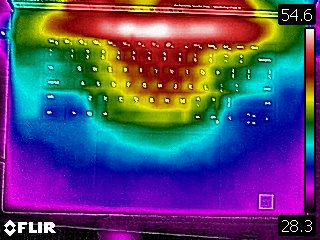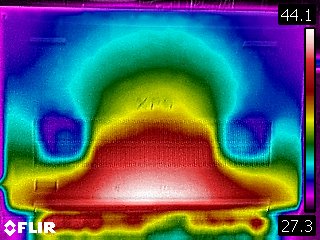Tom's Hardware Verdict
The Dell XPS 17's thin bezels highlight its gorgeous 17-inch screen, and it has the performance to match the size. Add a gaming-grade GPU and you have a solid all-rounder for those who love big screens.
Pros
- +
Slim bezels and attractive design
- +
Bright, vivid, 16:10 display
- +
Strong performance and gaming-grade GPU
- +
Massive touchpad
Cons
- -
Middling-quality webcam
Why you can trust Tom's Hardware
Dell’s XPS lineup has long included some of the best ultrabooks and premium laptops, but it’s been over a decade since we saw a 17-inch version. The XPS 17 (9700) is a triumphant return after a decade away, with a gorgeous display that almost floats in air on thin bezels, as well as solid CPU performance and the option for a gaming-grade GPU. If you were waiting for a bigger screen with this design, you’re finally getting one (and getting the performance to match).
Design of Dell XPS 17 (9700)


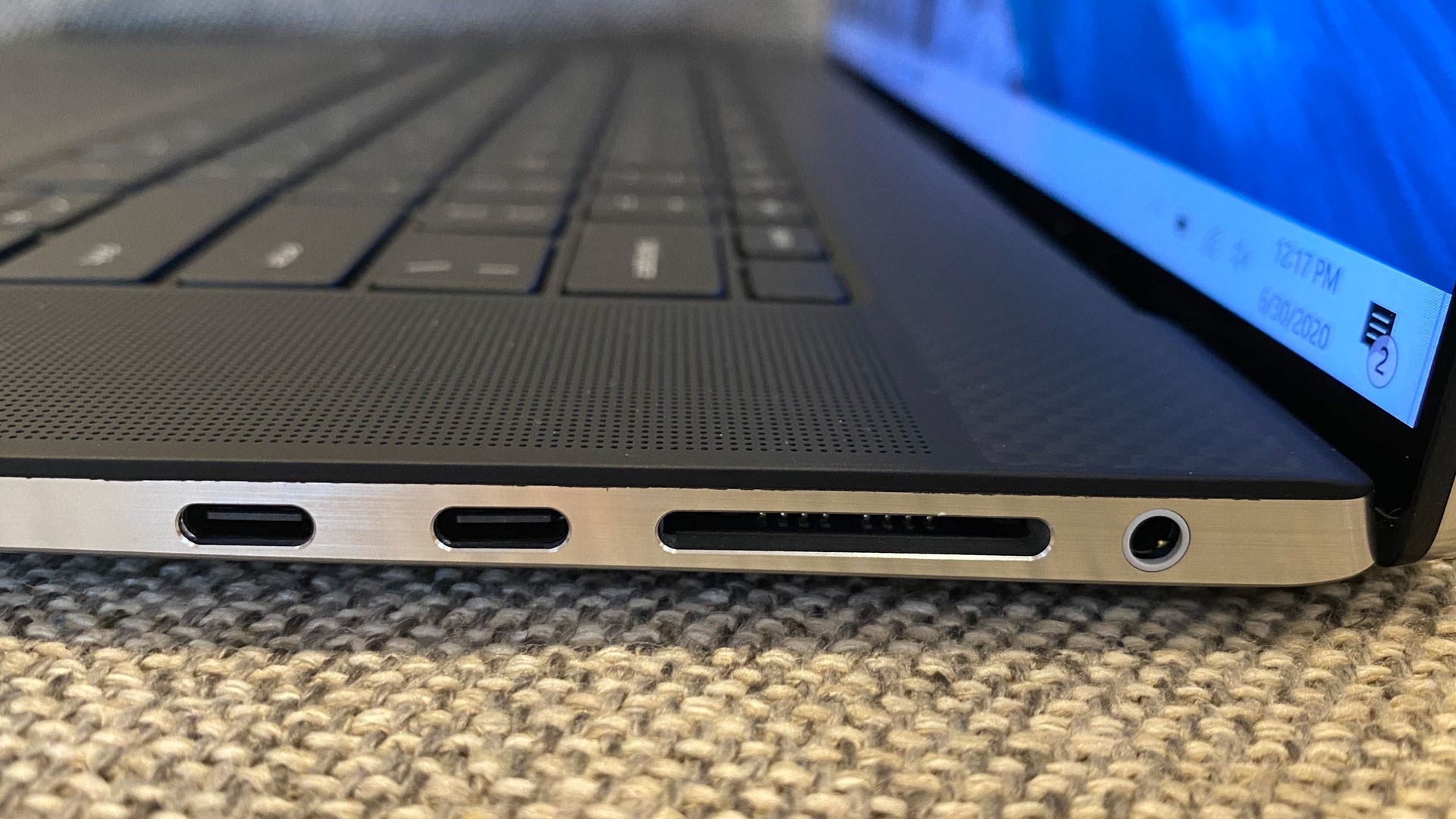


Dell has followed in Apple’s footsteps with the XPS lineup, making each laptop look largely the same. The XPS 17 follows in the footsteps of the Dell XPS 13 (9300) and Dell XPS 15 (9500), each of which launched earlier this year with slimmer profiles than ever before, as well as extending the InfinityEdge display to reduce the bottom bezel. The XPS 17 does that as well, just on a bigger scale.
That means its lid, just like the others, is made of silver aluminum with a Dell logo stamped on top. Like the other recent XPS notebooks, the XPS 17 has a 16:10 display, which provides slightly more vertical space on screen over typical 16:9 displays (this screen is 17-inches flat, rather than the more typical 17.3 inches). The hinge connecting the screen to the rest of the chassis feels extremely sturdy, even heavy.
Again, like its siblings, the XPS 17 has a carbon fiber palmrest that is smooth to the touch and comfortable against the wrists when typing. There’s plenty of room on the left and right sides of the keyboard for speaker grills, which are far larger than what the 15-incher offers.
There is a fingerprint reader in the power button, and the webcam, which is built into the thin top bezel of the display supports IR to unlock your PC with Windows Hello.
There are four Thunderbolt 3 ports on the XPS 17 -- two on each side. The left side also has a lock slot, while the right side also has a full-sized SD card reader and a 3.5mm headphone jack. Despite being ostensibly the most “Pro” of the XPS line, there’s still no USB Type-A, though Dell does include an adapter for USB Type-C to USB Type-A and HDMI out, for those who still use those standards.
At 14.7 x 9.8 x 0.8 inches and 4.7 pounds, the XPS 17 is larger than Apple’s biggest mobile offering, the 16-inch MacBook Pro, which is 14.1 x 9.7 x 0.6 inches and 4.3 pounds. The Gigabyte Aero 17 HDR is a bit larger at 15.6 x 10.6 x 0.8 inches and 5.5 pounds.
Dell XPS 17 (9700) Specifications
| CPU | Intel Core i7-10875H |
|---|---|
| Graphics | Nvidia GeForce RTX 2060 Max-Q (6GB GDDR6) |
| RAM | 32GB DDR4-2933MHz |
| SSD | 1TB NVMe SSD |
| Display | 17.0-inch, 3840 x 2400, 16:10 aspect ratio, touch |
| Networking | Killer Wi-Fi 6 AX1650s, Bluetooth 5.1 |
| Ports | 4x Thunderbolt 3, lock slot, 3.5 mm headphone jack, SD card reader |
| Camera | 720p webcam |
| Battery | 97WHr |
| Power Adapter | 130W |
| Operating System | Windows 10 Home |
| Size | 14.7 x 9.8 x 0.8 inches / 374.4 x 248.1 x 19.5 mm |
| Weight | 4.7 pounds |
| Extra | USB Type-C to USB Type-A and HDMI dongle |
| Price (as Configured) | $2,999.99 |
Productivity Performance of Dell XPS 17 (9700)
Our XPS 17 review unit came fully loaded with an Intel Core i7-10875H, Nvidia GeForce RTX 2060 Max-Q, 32GB of RAM and a 1TB PCIe NVMe SSD. Nevermind excessive Chrome tabs, this is enough muscle for some intense productivity work, though it didn’t win in every benchmark.
Get Tom's Hardware's best news and in-depth reviews, straight to your inbox.

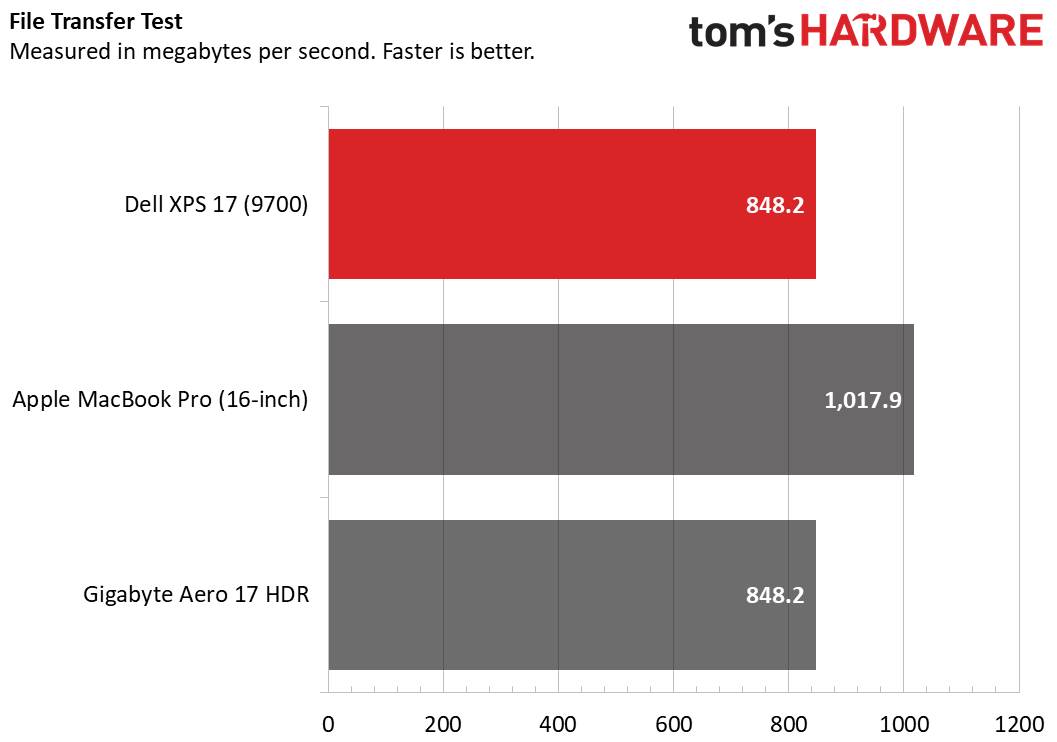


On Geekbench 5.0, the XPS 17 notched a score of 7,740, beating out the Gigabyte Aero 17 HDR (Intel Core i7-10875H, 7,357), and the 16-inch MacBook Pro (Intel Core i9-9980HK, 7,201).
It took six seconds for the XPS 17 to copy 4.97GB of files, a rate of 848.2 MBps. That’s the same as the Aero, but the MacBook Pro was faster at 1,017.9 MBps.
The XPS 17 completed our Handbrake video editing test in 8 minutes in 41 seconds. In that test, the laptop transcodes a 4K video to 1080p. Both the MacBook Pro (8:00) and Aero 17 (7:58) completed the task more quickly.
Our stress test for performance involves running Cinebench R20 on a loop 15 times. The scores were, after the first run, largely in the 2900 - 3000 range, though there was a slight bump to the latter end, consistently in the back part of the loop.
The CPU ran at an average clock speed of 3 GHz and an average temperature of 80.6 degrees Celsius (177.1 degrees Fahrenheit).
Gaming and Graphics for Dell XPS 17 (9700)
The Dell XPS 17 isn’t exactly billed as a gaming machine, but with an Nvidia GeForce RTX 2060 Max-Q, it’s certainly possible to play some games. Don’t expect to take advantage of the 4K+ screen on our review unit, but you can get respectable frame rates at 1080p.

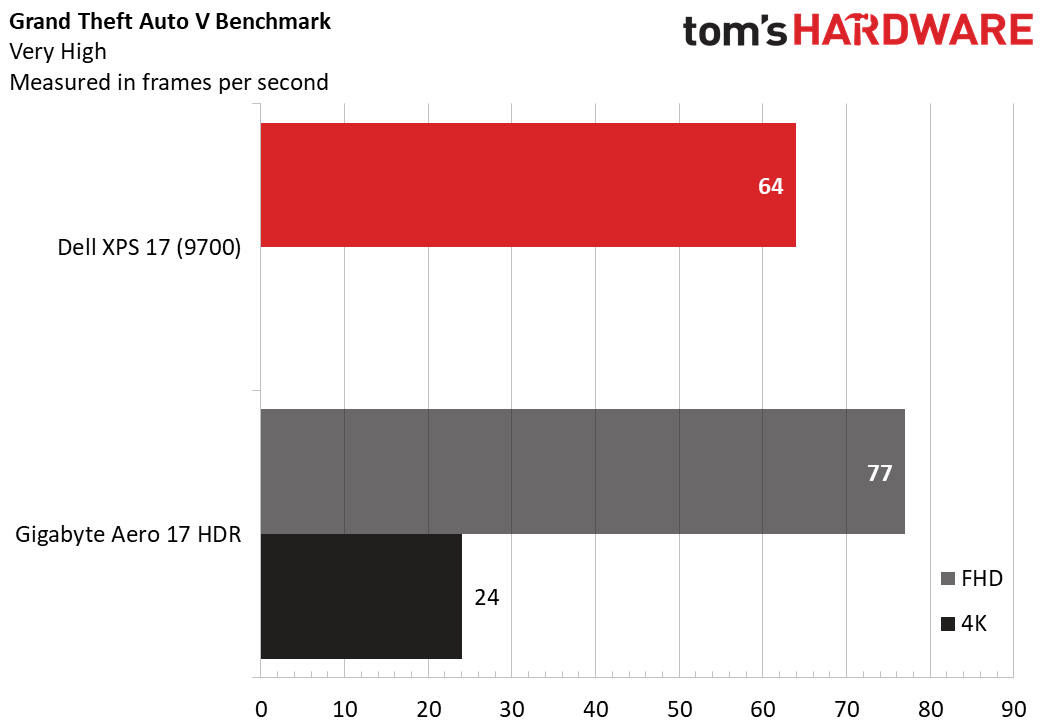

On Shadow of the Tomb Raider (1080p, highest), the XPS ran the game at 48 fps. The Aero 17, with an RTX 2070 Super, ran the game at 61 fps.
Next, we ran Grand Theft Auto V (1080p, very high), which the XPS ran at 64 fps compared to the Aero’s 77 fps.
On Far Cry New Dawn (1080p, ultra), the game ran at 66 fps on the XPS and 76 fps on the Aero.
Red Dead Redemption 2 (1080p, medium) is punishing, but still playable. The XPS 17 ran it at 35 fps compared to the Aero’s 43 fps.
We also ran our gaming stress test, which runs Metro Exodus on the RTX preset 15 times. The game ran at an average frame rate of 37.4 frames per second. Most runs ran at 37 fps, while some ran as low as 34 or as high as 38 fps.
During this test, the CPU ran at an average of 3.1 GHz and measured 76.6 degrees Celsius (169.9 degrees Celsius). The GPU’s average clock speed was 1308 MHz and the average temperature was 71.2 degrees Celsius (160.2 degrees Fahrenheit).
Display
The 17-inch display on the XPS 17 uses a 16:10 aspect ratio. Most laptops go with 16:9, but 16:10 allows for slightly more vertical space to work, which is very welcome. We reviewed a version with a 3840 x 2400 touchscreen (slightly over 4K), though a non-touch version closer to FHD (1920 x 1200) is available. Our review unit was extremely bright and showed vivid colors when I watched the 4K short Tears of Steel. The film’s bright colors range from green and purple holograms to red cyborg eyes and a blue cityscape, and they all looked great.
Dell’s screen covers 121.6% of the DCI-P3 color gamut, easily surpassing the MacBook Pro (80.7%). It’s rivaled only by the Gigabyte Aero 17 HDR at 115.1%, but even that falls behind.
The XPS 17’s panel is also the brightest of the bunch at an average 505 nits of brightness. That’s far more luminous than either the MacBook Pro (429 nits) or Aero 17 (466 nits).
Keyboard and Touchpad
The keyboard on the XPS 17 is the right mixture of quiet and clicky. It isn’t terribly loud, but it’s not sacrificing much in the way of travel. It has a slightly bouncy feel; I never quite bottomed out on the keys, as they always popped back up. On the 10fast fingers.com typing test, I reached an average of 106 words per minute with a 2% error rate, all of which is pretty normal for me.
One might think that a 17-inch laptop could fit a full-sized numberpad, but Dell has opted not to add one. I prefer the centered keyboard while on the go, but I could see some professionals or data input experts missing the number keys.
The touchpad is extremely spacious at 5.8 x 3.5 inches. There’s plenty of room for navigating and gesturing, and, thanks to Windows precision drivers, everything seemed to work right on the first try.
Audio
The top-firing speakers on the XPS 17 are powerful and clear. They blasted out music directly at me while I used the computer and listened to Neon Trees’ “Sleeping With a Friend.” Sound output was a little quieter around the rest of my apartment, but it did ultimately fill my one-bedroom, so the laptop does the job. The song’s vocals, synths, drums and cymbals all came through well-balanced and clear, but like many laptops, the XPS 17 lacks bass, putting it behind the 16-inch MacBook Pro in this regard. I could pull out a hint of it in the Waves MaxxAudioPro software, but not enough to make a big difference.
Upgradeability
There are eight Torx screws on the bottom of the Dell XPS 17. A Torx 4 screwdriver got those out easily enough.
The base plate is held to the rest of the chassis with small clips. This is a design in which the cutouts for the I/O are attached, which I’ve always found the most annoying to remove. It took a bit of time with a spudger, but with some patience I was able to crack the XPS open.
The cooling in here is fairly impressive; the CPU and GPU are covered by copper and with extra room, Dell’s fans are much larger than what we usually see even in gaming laptops.
The RAM is immediately accessible should you want to add or upgrade SODIMMs. The dual m.2 SSDs appear to be easy to change out, but the screws holding in the battery also hold down the copper heat sinks over the storage. While taking the battery out is often good practice when working with electronics, this practice may irk some who are willing to risk a quick swap without doing so.
Battery Life
The 97 WHr battery in the Dell XPS 17 took it far on a charge in our battery test, which continuously browses the web, streams video and runs OpenGL tests in the browser, all over Wi-Fi at 150 nits of brightness. The laptop ran for 9 hours and 5 seconds.
It was beat by the MacBook Pro, which lasted an hour and 50 minutes longer at 10:55. It’s possible that the lower resolution screen option on the XPS 17 would put it ahead here, but we didn’t test that version.
The Gigabyte Aero 17 HDR fell behind the competition with a run time of 6:28 that will require you to carry a charger around.
Heat
Dell made the XPS 17 incredibly thin, but it can get a touch warm under load. We took some skin temperatures while we ran our Cinebench stress test.
The keyboard between the G and H keys measured 45.7 degrees Celsius (114.3 degrees Fahrenheit), but the touchpad kept cool at 32.4 degrees Celsius (90.3 degrees Fahrenheit).
The hottest point on the bottom of the laptop measured 44.1 degrees Celsius, (111.4 degrees Fahrenheit).
Webcam
Dell keeps the top bezel very slim, which requires a custom 720p webcam to fit. It’s a far better solution than having the camera below the screen, which is the perfect angle to look at your chin, but the image quality isn’t amazing here. A photo I took in a well-lit area of my apartment was grainy and just a tad dark. The colors were largely accurate, including my bright yellow t-shirt.
Software and Warranty
Dell has been adding an increasing amount of preloaded software to its laptops the past few years. Many of these programs are helpful, though a few seem unnecessary.
Perhaps the best addition is Dell Mobile Connect, which lets you make calls, send texts, see notifications or transfer files (it works best with Android). For creatives, Dell Premier Color is a calibration app and lets you make adjustments to color spaces.
Dell Cinema Guide is a version of Reelgood, which lets you add your streaming service subscriptions to watch any movie or show from those programs. This one seems a bit extra. Additionally, Dell has added Netflix, which seems contradictory, as well as Dropbox and a trial of Dolby Access.
There’s also the usual bloat that comes with Windows 10, including Hotspot Shield Free VPN, Spotify, Hulu and Candy Crush Friends, among others.
Dell sells the XPS 17 (9700) with a 1-year warranty.
Configurations
We reviewed the Dell XPS 17 in a $2,999.99 configuration with an Intel Core i7-10875H, Nvidia GeForce RTX 2060 Max-Q GPU, 32GB of RAM, 1TB of storage, and a 3840 x 2400 touchscreen. That’s the top of the line.
The base model, starting at $1,399.99, uses an Intel Core i5-10300H with integrated graphics, 8GB of DDR4 RAM, 256GB of PCIe NVMe SSD storage and a 1920 x 1200 non-touch display.
For $1,899.99, you get the Intel Core i7-10875H paired with a GTX 1650 Ti, the 1920 x 1200 screen, 8GB of RAM and a 512GB SSD.
You can get a slightly cheaper variant of our review model for $2,849.99 by moving down to 16GB of RAM.
Bottom Line
The Dell XPS 17 (9700) is a desktop-replacement with a massive 17-inch display. That screen is bright and gorgeous, with accurate color reproduction. It offers strong CPU performance, a GPU capable of gaming and solid battery life. It’s pricey, but not crazy considering its competitors’ price tags.
Creatives who need more GPU performance may want to opt for something like the Gigabyte Aero 17, which also has a nice screen and a slim build, but has a more powerful Nvidia GeForce RTX 2070 Super (which can also deliver some 4K gaming).
Mac users will naturally gravitate to the 16-inch MacBook Pro, which has better sound and runs macOS, but the XPS 17 takes the fight to Apple here. Big screen laptop lovers, your time is now.

Andrew E. Freedman is a senior editor at Tom's Hardware focusing on laptops, desktops and gaming. He also keeps up with the latest news. A lover of all things gaming and tech, his previous work has shown up in Tom's Guide, Laptop Mag, Kotaku, PCMag and Complex, among others. Follow him on Threads @FreedmanAE and BlueSky @andrewfreedman.net. You can send him tips on Signal: andrewfreedman.01
-
chickenballs yeah 3k for a laptop with 2060 Max Q....Reply
why the high res screen though because the gpu is inadequate for most modern games at that resolution -
Trident1983 Reply
Laughs. Takes 4k 60hz video in the dark making it like it's the middle of the same with webcam. Fixes the green leaf yep script on hp omen to make the Intel desktop and then laptop sip tdp on all ssds CPUs gpus and RAM post chrome web browser. Also fixes the 4k laptop monitor for lighting sensor for light dark detection for screen color correction and brightness using ai and for webcam using lidar for security and for recharging the laptop when your away from your computer using solar panels. Linus can shut up for now and that other troll as you not though enough as your late.nofanneeded said:missing cons : Very Expensive !!! -
informskumar The Keyboard of the Laptop should have been with Numeric Keypad. Keyboard without the numeric keypad for such a large laptop is certainly inconvenience to use when the user needs to key in figures and deal with numbers. Day by day, the designers lack sense and they are not weighing the most important cons of their own design flaws like this. Whether these newgen designers agree or not, keyboard with numeric pad is of course more convenient and is a must for keying in numbers.Reply -
thuckabay Dell needs to put in a much better webcam, as the crap ones are old and should not be considered acceptable these days. The XPS 17 of a decade ago had a much better one! Also, the machine should have a subwoofer and and AMD CPU option.Reply -
jorger101 HelloReply
This is my first post at Tom's Hardware. Reading Tom's review on the XPS 17 convinced me that it is the machine for me. I was considering buying the XPS 13 2-in1 from Dell, but after reading reviews about it, I found out that the memory and the storage are not upgradable. That was a deal breaker for me. I have a very cheap Dell laptop that I bought during Christmas and I was able to upgrade the memory and the storage with very little trouble myself. Your review showed that those components are upgradable in the XPS 17. Today I just ordered mine. I got one with 16 GB of Ram, and 512 GB of storage with the 4k display. I plan to upgrade the memory to 64 GB and purchase a couple of 2 TB M.2 drives. With that powerful laptop, I will be set for quite a while. Thanks very much for such a thorough review with excellent information that I can use. -
jorger101 That is a good question, but in order to answer it, you would have to have both. Maybe someone here knows.Reply -
nofanneeded Replykanayamasha said:hello, does the XPS 17 i7 10750H FHD + heat up less than the 4k version?
it depends on the game you are playing and the GPU+CPU load ... if it is 100% load does not matter if it is 4k or FHD screen ...
But in General , GPU will work 100% to render in 4K so yes it will heat up more if you play in 4K resolution more than FHD .. but again this Notebook GPU is not for 4K gaming.



